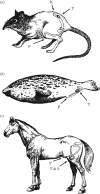Effects of heat stress on mammalian reproduction
- PMID: 19833646
- PMCID: PMC2781849
- DOI: 10.1098/rstb.2009.0131
Effects of heat stress on mammalian reproduction
Abstract
Heat stress can have large effects on most aspects of reproductive function in mammals. These include disruptions in spermatogenesis and oocyte development, oocyte maturation, early embryonic development, foetal and placental growth and lactation. These deleterious effects of heat stress are the result of either the hyperthermia associated with heat stress or the physiological adjustments made by the heat-stressed animal to regulate body temperature. Many effects of elevated temperature on gametes and the early embryo involve increased production of reactive oxygen species. Genetic adaptation to heat stress is possible both with respect to regulation of body temperature and cellular resistance to elevated temperature.
Figures








References
-
- Alexander G., Hales J. R. S., Stevens D., Donnelly J. B.1987Effects of acute and prolonged exposure to heat on regional blood flows in pregnant sheep. J. Dev. Physiol. 9, 1–15 - PubMed
-
- Al-Katanani Y. M., Webb D. W., Hansen P. J.1999Factors affecting seasonal variation in 90 day non-return rate to first service in lactating Holstein cows in a hot climate. J Dairy Sci. 82, 2611–2615 - PubMed
-
- Al-Katanani Y. M., Paula-Lopes F. F., Hansen P. J.2002Effect of season and exposure to heat stress on oocyte competence in Holstein cows. J. Dairy Sci. 85, 390–396 - PubMed
-
- Aréchiga C. F., Hansen P. J.1998Response of preimplantation murine embryos to heat shock as modified by developmental stage and glutathione status. In Vitro Cell Dev. Biol. Anim. 34, 655–659 (doi:10.1007/s11626-996-0016-8) - DOI - PubMed
-
- Aréchiga C. F., Ealy A. D., Hansen P. J.1995Evidence that glutathione is involved in thermotolerance of preimplantation mouse embryos. Biol. Reprod. 52, 1296–1301 (doi:10.1095/biolreprod52.6.1296) - DOI - PubMed
Publication types
MeSH terms
LinkOut - more resources
Full Text Sources
